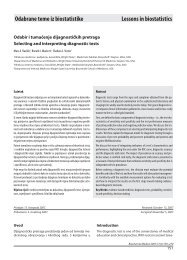Posterske teme Poster topics - Biochemia Medica
Posterske teme Poster topics - Biochemia Medica
Posterske teme Poster topics - Biochemia Medica
You also want an ePaper? Increase the reach of your titles
YUMPU automatically turns print PDFs into web optimized ePapers that Google loves.
P3-4 Koagulacija<br />
laboratorijski obrađeno 197 ispitanika zbog sumnje na<br />
poremećaj primarne hemostaze, te je napravljena korelacija<br />
PFA-100 s VWF:RCo (r=-0,5091 za CEPI; r=-0,5649 za<br />
CADP) i s VWF:Ag (r=-0,4003 za CEPI; r=-0,5223 za CADP).<br />
Logaritamskom transformacijom dobivena je jača korelacija<br />
s VWF:RCo (r=-0,6423 za CEPI; r=-0,7403 za CADP), kao<br />
i s VWF:Ag (r=-0,4879 za CEPI; r=-0,6117 za CADP). Ispitivanjem<br />
korelacije vremena krvarenja po Ivyju s PFA-100<br />
dobiveni su bolji rezultati (r=-0,4291 za CEPI; r=-0,5614 za<br />
CADP) nego s VWF (r=-0,2216 za VWF:RCo; r=-0,1590 za<br />
VWF:Ag). Potpuno podudaranje rezultata između PFA-100<br />
i ispitivanja PA (oba rezultata patološka ili oba normalna)<br />
dobiveno je u 94/162 (58%) ispitanika. U skupini od 96 ispitanika<br />
s normalnim nalazom PA, u 72 (75%) je dobiven<br />
normalan rezultat za CEPI-CT i CADP-CT, u 13 (13,5%) ispitanika<br />
dobiven je barem jedan patološki nalaz na PFA-<br />
100, dok su oba patološka rezultata dobivena u 11 (11,5%)<br />
ispitanika. Od 66 ispitanika s patološkim vrijednostima PA<br />
s najmanje jednim agonistom, oba patološka rezultata na<br />
PFA-100 nađena su u 22 (33,3%) ispitanika, barem jedan<br />
normalan rezultat dobiven je u 15 (22,7%) ispitanika, a oba<br />
normalna nalaza su dobivena u 29 (44,0%) ispitanika. U<br />
zaključku, normalan nalaz CEPI-CT i CADP-CT ne može isključiti<br />
sve poremećaje primarne hemostaze zbog izrazite<br />
složenosti primarne hemostaze te velikog broja različitih<br />
poremećaja funkcije trombocita.<br />
E-mail: marijamilos1@yahoo.com<br />
P3-5<br />
Predviđanje stupnja defi cita FVIII analizom<br />
reakcijskih krivulja za APTV<br />
Miloš M, Coen-Herak D, Zadro R<br />
Klinički zavod za laboratorijsku dijagnostiku, Klinički bolnički centar<br />
Zagreb, Zagreb, Hrvatska<br />
Na modernim koagulacijskim analizatorima APTV ne<br />
predstavlja samo broj, nego skup foto-optičkih podataka<br />
u obliku reakcijske krivulje. U ovom radu napravljena je<br />
kvantitativna analiza reakcijskih krivulja za APTV na analizatoru<br />
Behring Coagulation Timer (BCT) te je pomoću<br />
dobivenih parametara ispitana mogućnost predviđanja<br />
stupnja defi cita FVIII. U uzorcima plazme 38 zdravih ispitanika<br />
i 87 bolesnika s hemofi lijom A izmjeren je APTV (Actin<br />
FS) uporabom dviju metoda procjene reakcijske krivulje:<br />
zadana promjena apsorpcije (fi x e d a b s o r b a n c e , APTV-FA) i<br />
točka infl eksije (point of infl exion, APTV-PI). Zatim su izračunati<br />
slijedeći parametri: delta-APTV (DaPTT) kao razli-<br />
<strong>Biochemia</strong> <strong>Medica</strong> 2006;16(Suppl 1):S1–S268<br />
S108<br />
was found to be 80-160 s for CEPI-CT, and 60-120 s for<br />
CADP-CT. The PFA-100 CTs were correlated to VWF:RCo<br />
(r=-0.5091 for CEPI; r=-0.5649 for CADP), and to VWF:Ag<br />
(r=-0.4003 for CEPI; r=-0.5223 for CADP). With logarithmic<br />
transformation of data, we obtained an even stronger<br />
correlation to VWF:RCo (r=-0.6423 for CEPI; r=-0.7403 for<br />
CADP), as well as to VWF:Ag (r=-0.4879 for CEPI; r=-0.6117<br />
for CADP). Bleeding times were correlated much better to<br />
PFA-100 CTs (r=0.4291 for CEPI; r=0.5614 for CADP) than<br />
to plasma VWF levels (r=-0.2216 for VWF:RCo; r=-0.1590<br />
for VWF:Ag). The overall agreement (both normal or both<br />
abnormal) between PFA-100 and PA was 94/162 (58%).<br />
In the group of 96 patients with normal PA results, both<br />
normal CTs were found in 72 (75%), at least one abnormal<br />
CT in 13 (13.5%), and both abnormal CTs in 11 (11.5%) patients.<br />
Among 66 patients with at least one abnormal PA<br />
result, both abnormal CTs were observed in 22 (33.3%), at<br />
least one normal CT in 15 (22.7%) and both normal CTs in<br />
29 (44.0%) patients. In conclusion, normal CTs could not<br />
exclude all primary hemostasis disorders, probably due<br />
to the large number and variety of platelet defects.<br />
E-mail: marijamilos1@yahoo.com<br />
P3-5<br />
Is it possible to predict the degree of FVIII<br />
defi ciency from aPTT waveform analysis on a<br />
Behring Coagulation Timer (BCT)?<br />
Miloš M, Coen-Herak D, Zadro R<br />
Coagulation<br />
Clinical Institute of Laboratory Diagnosis, Zagreb University Hospital<br />
Center, Zagreb, Croatia<br />
With modern coagulation instruments, every aPTT result<br />
is not just a number but a collection of photo-optical<br />
data in the form of reaction curve. We performed a quantitative<br />
aPTT waveform analysis to see whether it was<br />
possible to detect the degree of FVIII defi ciency using parameters<br />
from this analysis. We measured aPTT (Actin FS)<br />
in 38 normal subjects and 87 hemophilia A patients on a<br />
Behring Coagulation Timer, with two diff erent evaluation<br />
modes: fi xed absorbance (FA) and point of infl exion (PI).<br />
Additionally, we calculated delta-aPTT (DaPTT) as aPTT-PI<br />
minus aPTT-FA and aPTT-slope ratio (aPTTSR) as the ratio<br />
between DaPTT and aPTT-FA. FVIII activity was measured






